Home » Jazz Articles » Jazz in Long Form » Strange Bedfellows: Jazz and Pop and Heinrich Schenker?
Strange Bedfellows: Jazz and Pop and Heinrich Schenker?
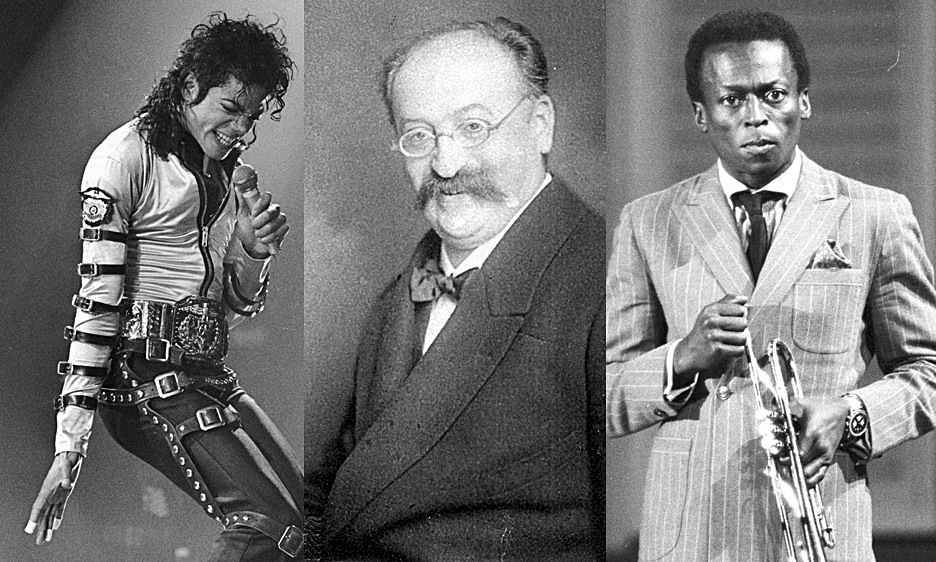
...the applied nature of their work as jazz musicians makes them practicing Schenkerians who immediately see the background structure and work intimately with it, even in their first encounters with new works.
I. A Brief Introduction to Schenkerian Analysis
Heinrich Schenker (1868-1935) was an Austrian musician, composer, and most notably, music theorist whose ideas about analyzing and explaining music were groundbreaking and successful. Along with other theories, like Allen Forte's "Set Theory" and Arnold Schoenberg's "Serialism" (two mathematically oriented theories of analysis (Set Theory) and music composition (Serialism), Schenker's theories were very popular in academia. These theories were well-suited for higher education—they are complex, abstract, and have their own terminologies. In Schenker's work, terms like Ursatz ("fundamental structure"), Urlinie ("fundamental line"), Bassbrechung ("bass arpeggiation"), Ausfaltung ("unfolding"), Tieferlegung ("descending register transfer"), Auskomponierung ("composing out"), and many others appeared as the new theory's lexicon was created. These concepts had to be learned and understood by initiates who wanted to engage in the new "Schenkerian Analysis." These sub-disciplines were a perfect fit for music theorists in the burgeoning music departments in higher education who eagerly embraced them.While interesting and valid, these theories failed in one important respect—they were not replicable. One person's Schenkerian analysis could be different from another's, one person's Set Theory analysis of a work could also be different from another's. They were revealed to be a creative and subjective method of analysis that revealed how the theorist was hearing the music and the structural relationships within.
Schenker's theories were very successful and popular in the 20th century—Schenkerian analysis quickly became a highly respected area of specialization in music theory. Theorists and composers studying at the graduate level encountered his theories. They were trained in his methods, and music theorists built their careers by publishing Schenkerian analyses in music theory journals.
Example 1 is a Schenkerian analysis 1 of three cadences by Schenkerian theorist Jeremy Day- O'Connell:
Example 1): Schenkerian Analysis of Cadences from Claude Debussy (a) and Richard Wagner (b) in comparison to an Authentic Cadence (c)
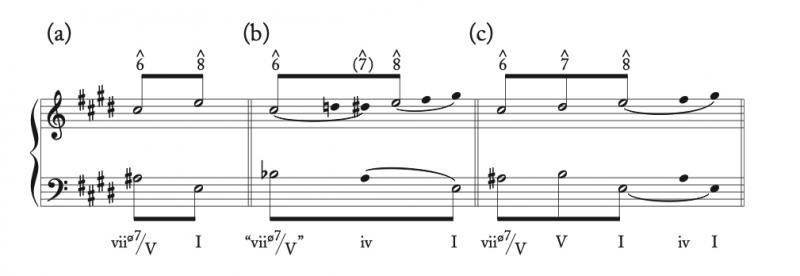
(a) Claude Debussy (1862-1918), from "Pellás et Mélisande," m. 108,
(b) Richard Wagner (1813-1883), transposed ending from "Tristan und Isolde," and
(c) A generic authentic cadence (V-I) with "plagal confirmation."
The Schenkerian analysis, as the final reduction of the piece, is the "background." Note how much is missing in the reduction—the rhythms and melodies are completely gone; Only the skeletal remnants of the harmonic pillars remain. It would be impossible to identify these well-known works from these famous composers by looking at the reduction. (To be fair, Schenker's explicit goal is to reveal the harmonic structure of the music—melodies are viewed as part of the harmonic explication, and rhythm is recognized only by how it emphasizes harmony by placement on strong beats and cadences, or by duration.)
Day-O'Connell uses this reductive Schenkerian analysis to show how "...Debussy appropriates that chord for a strange new harmonization of the plagal leading tone, a cadence that represents a contraction of Wagner's (which in turn represents a contraction of a classical cadential prototype) 2..." This would be difficult to see at the foreground level, but at the background level, we easily see structural similarities between these two composers, who are stylistically diametrically opposed. Additionally, the reduction shows a deep connection to the generic authentic cadence that reaches back into antiquity. Day-O'Connell thus convincingly demonstrates a lineage that winds through the entire history of classical music.
How does a Schenkerian theorist remove the foreground and middle ground activity? The theory partially rests on the idea that a chord can be "prolonged," which means that even while other chords are being played, they are not "structural"—they function to prolong the primary harmony in a more interesting manner than simply repeating the primary chord. We can think of these as "decorative" gestures that can be removed to reveal the structures at the foundation of the music. The chords that perform the function of prolongation (prolonging the primary harmony) are thus called "embellishing chords." 3
With all of this complicated theoretical analysis, one might think that this cerebral theory has no application in the "real world," but that is not the case—evidence for the validity of Schenker's theories can easily be found in classical music, jazz, pop, and virtually every other genre of tonal music.
There are two primary forms of these embellishing chords:
- Passing Chord (P)
The passing chord connects two chords by stepwise movement in the bass or over a pedal tone. Often, it connects a chord in root position to the same chord in first inversion. - Neighbor Chord (N)
The neighbor chord moves to another chord and then moves back to the original chord, either from above that chord ("upper neighbor"—UN), or below that chord ("lower neighbor"—LN).
These embellishing chords are often the dominant (V or V7) or subdominant chord (IV), but can also be found on other chords. They are found regularly in classical music, jazz, folk music, and popular music of all kinds.
Here is an example from Beethoven's famous Sonata for Piano #8, "Pathetique." In the main theme, which appears after the long and dramatic introduction, we find both types, neighbor and passing chords, in quick succession, both prolonging the tonic chord, C minor. See Example 2a.
Example 2a): Beethoven's Sonata #8, "Pathetique," 1st movement, mm. 11-18

The Schenkerian perspective here is an aerial view from which this entire phrase is shown to proclaim "C Minor" dramatically and forcefully. Example 2b)4 shows the opening phrases with the embellishing chords deemphasized. The entire phrase is a prolongation of the tonic! (Schoenberg's comment comes to mind, in that "my favorite parts" are not there, but again, that is not the point.) Try to listen to the example several times with this in mind to get an idea of what it is like to listen to the longer-term harmonic movements.
Example 2b): Harmonic Reduction, Beethoven's Sonata #8, "Pathetique," mm.11-18

So, what is the point? First, seeing the structure allows us to see and hear the same structural frameworks in other pieces—the analysis becomes an almost algebraic version of the piece. Listening in this manner can help us grasp the longer forms more easily, and it also allows us to focus more on the development of the motifs, which can be overwhelmed by the quickly shifting chords. So, in a sense, listening this way helps us to engage with the music in a more balanced way. By enlarging the conceptual framework, we can more easily understand and engage with longer works, which also assists in the memorization of the piece.
For composers and composition teachers, there is also a pedagogical element here. We see that the structures of tonal music are similar across various eras and composers. Genius and individuality, therefore, occur largely in the foreground and middle ground. For composers, this provides a means of large-scale planning where the composition "grows out" of the harmonic sketch and is thus more internally coherent, which is an approach that can be utilized even if the piece is not tonal.
II. Modal Prolongation in Popular Music and Jazz
In popular music, the verses of songs are often vamps that feature three or four chords that are, from a harmonic perspective, short embellishing figures that prolong the primary harmony. Choruses and bridges are similar—they also tend to prolong a single primary harmony, but there is usually some harmonic contrast (key change, mode change, etc.) with the other sections of the song.5Here is an example of this in popular music— Michael Jackson's smash hit song "Billie Jean." (With over a billion and a half views, calling it "popular" seems like an understatement.) The bass line outlines C minor (Dorian mode), and the string chords feature the tonic chord in first inversion. An embellishing passing supertonic chord (ii, also in first inversion) follows, which connects it to the tonic chord in second inversion, and then to the supertonic in first inversion and back to the tonic. See Example 3a.
Example 3a) Verse from Michael Jackson's "Billie Jean"
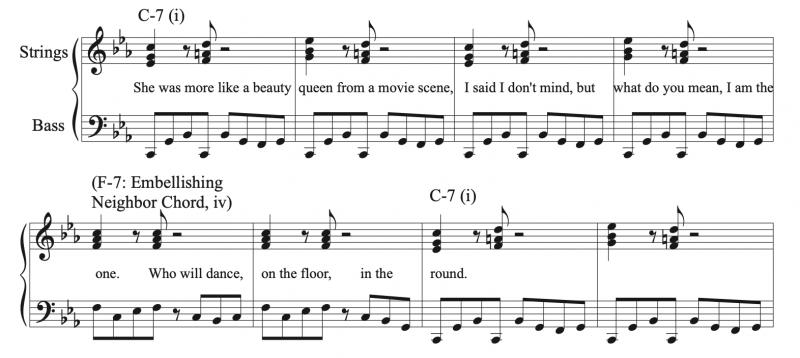
The accompaniment melody in the strings is scale degrees 1-2-3-2-1 (C-D-E♭-D-C, the caret over the number reads as "scale degree number 1," etc.). Additionally, the subdominant chord (iv, F minor 7) is embellishing as well—it is a neighbor chord that prolongs the overall C minor (Dorian) harmony melodically, just like the passing chord on the supertonic. See Example 3b.
Example 3b): Melody in String Accompaniment in the Verse of "Billie Jean"

Here is a more complicated example from Steely Dan—the verse here is essentially the same embellishing figure as in "Billie Jean." The first part of the verse is a vamp in C minor (Dorian) that prolongs the tonic harmony through embellishing chords. See Example 4.
Example 4) Verse of Steely Dan's "FM"
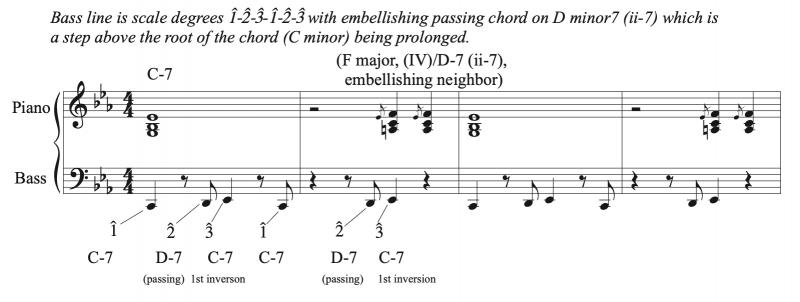
After the verse, there is a bridge, which begins with the lyrics "The girls don't seem to care." This is where some more sophisticated chordal movement arrives that effectively ends the prolongation of C minor. It leads us briefly through C major, before a return to C minor for the second verse. The second bridge is a variation on the first that does not lead us back to the verse—instead, it leads to the short chorus: "FM, No static at all..."
Note the striking similarities with "Billie Jean"—the prolongation techniques and materials are identical. In "Billie Jean," the melody of the string accompaniment is scale degrees 1-2-3, which is found in the bass line of "FM." Note the similarities with "Billie Jean"—the prolongation techniques are almost identical. In "Billie Jean," the melody of the string accompaniment is scale degrees 1-2-3, which is found in the bass line of "FM." Also, both use the same chord for prolongation—a minor seventh chord (D minor 7) a step above the tonic as a passing chord ("Billie Jean") and as a neighbor chord ("FM").
Moving to the jazz realm, here are two examples from Miles Davis. This is "All Blues" from his epoch-defining recording from Kind of Blue (Columbia, 1959). See Example 5a.
Example 5a): Piano Accompaniment Chords from Miles Davis' "All Blues"
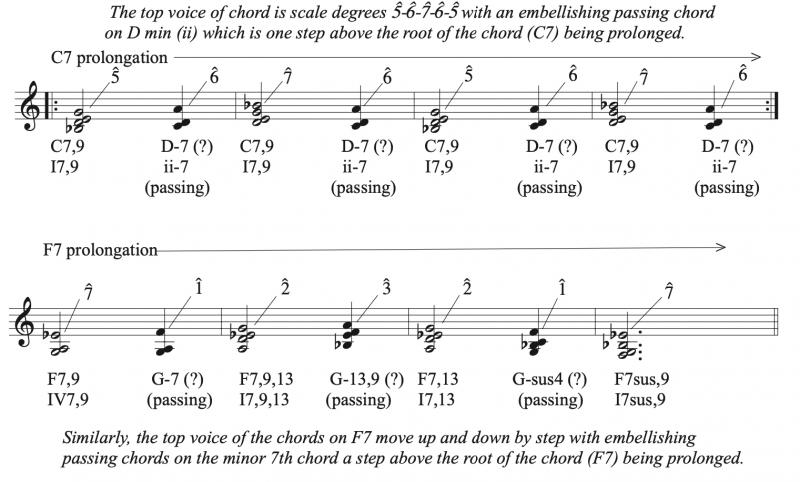
"Milestones" is an interesting piece in that the cadence of the 'A' section is not on the tonic, giving the piece an open-ended quality that makes the tonic somewhat ambiguous. Similarly, the 'B' section ends somewhat unresolved, with a B♭major chord over D minor that highlights the dissonance between the 5th of the D minor chord and the lowered 6th (E♭) of the Aeolian mode. This mirrors the cadence in the 'A' section, ending the 'B' section with a darker hue.
The 'B' section is in D minor (Aeolian), a neighbor to the C minor (Dorian) 'A' section. Additionally, the melody of the 'B' section is a variation on the melody from the 'A' section. It is the same three-note rising motif, but instead of the edgy, aggressive staccato version in the 'A' section, in the 'B' section each note gets two full beats. Some interpolations embellish it, which completely changes the character of the motif as it shows us, Janus-like, its dreamier, melancholic side. See Example 5b.
Example 5b): Miles Davis' "Milestones," 'B' section

These are examples of popular music from the "King of Pop," Michael Jackson, from the jazz-rock supergroup, Steely Dan, and from jazz icon Miles Davis. In terms of style, they could not be more different, and yet, as can be seen from the analysis, all three utilize the exact same embellishing device—passing chords using a minor seventh chord a step above the root of the prolonged tonic chord. Two feature scale degrees 1-2-3 prominently—in "Billie Jean," this is found in the melody of the string accompaniment, and in "FM," it is found in the bass line. The other two feature the same stepwise movement, but they start on different scale degrees—in both "All Blues" and "Milestones" it is scale degrees 7-1-2 (or 7-8-9 to highlight its stepwise motion). From this Schenkerian perspective, these sections of these four pieces are structurally the same, so we have precisely the same effect as in the Beethoven example—the individuality of the three pieces emerges in the middle-and foreground layers.
In this way, I contend that jazz musicians, in particular, engage in Schenkerian analysis as a matter of course in their approach to improvisation and composition. Professional jazz musicians can look at a new chart, and instantly see its harmonic "background." This involves identifying structural chords that denote key areas and modulations, while at the same time relegating embellishing chords to the foreground, where they can often be ignored. Indeed, this is difficult for young jazz musicians to understand—there are a lot of chords on the page, and amateur jazz musicians are unable to place them in a structural hierarchy. This is something that jazz teachers regularly do for their students. Identifying the background greatly simplifies the improvisational options for young musicians. Again, professional musicians do this as a matter of course—the applied nature of their work as jazz musicians makes them practicing Schenkerians who immediately see the background structure and work intimately with it, even in their first encounters with new works.
For example, the chord changes from George Gershwin's hit from 1930, "I Got Rhythm," are used for many jazz standards, including "Anthropology," "Scrapple from the Apple," "Oleo," and many others, including famously, even the theme to The Flintstones! When young players first encounter these changes, which are called "rhythm changes," they are usually overwhelmed. It is difficult to improvise over these chord changes because the tempo is fast, and the chords in the 'A' section change every two beats. To outline all of those chord changes is something that professionals have mastered. Still, for young musicians, it is a giant leap from improvising over a slower tempo modal tune like "So What" to playing rhythm changes successfully.
The 'A' section of rhythm changes is energetic, perhaps even frenetic, with chords changing quickly in quick succession. However, from a Schenkerian perspective, that high level of chordal and rhythmic activity is masking a very simple prolongation of B♭major. See Example 6.
Example 6: 'A' Section from Sonny Rollins' "Oleo" (Rhythm Changes)
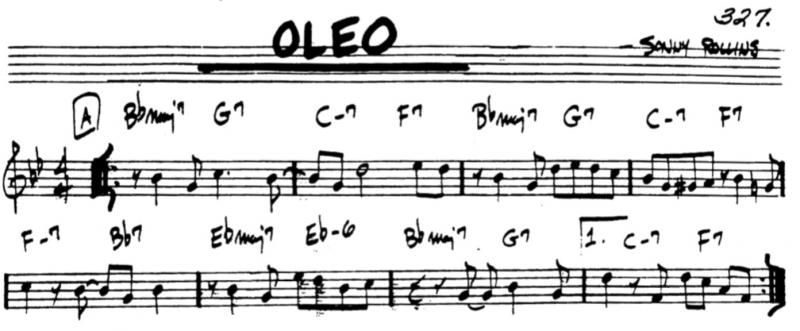
From this Schenkerian perspective, these eight measures are simply a prolongation of B♭major—the first four measures are a common "turnaround" that cycles back and forth to B♭major. Then, it briefly tonicizes E♭major (neighbor) before some chromatic voice leading (♭6-♭6-5) which ends the phrase with the same turnaround. Thus, 75% (six of the eight measures) of the phrase is just cycling through a B♭major turnaround. As previously mentioned, this is something that professional jazz musicians intuitively know, and they demonstrate it in their improvisations.
For example, here is Sonny Rollins, the composer of the piece, performing the piece at breakneck speed. His first chorus (starting at 0':23") ignores the chord changes entirely, plays a simple two-note figure (on scale degrees 5-6, F and G), and ends with a bluesy figure. High school student could easily play these notes and figures, but what follows in Rollins' improvisation they could not.
Here is another example of Rollins' "Oleo," at a much slower tempo, with Miles Davis taking the first solo. Davis' first chorus largely ignores the chord changes as well.
Most of his first two times through the 'A' section highlight the tonic chord with simple diatonic embellishment using the B♭major scale, and, like Rollins, he ends with a bluesy lick. As before, a high school student could also easily play most of this.
Thus, Rollins and Davis (and virtually every jazz musician who has played rhythm changes) confirm Schenker's theory of harmonic prolongation in their improvisations by simply playing in B♭major or using B♭blues. The usefulness of Schenkerian analysis is clear—to start with rhythm changes, young musicians should be told to ignore the chords and improvise melodically using B♭major and B♭blues. Once they have some confidence with the simpler materials that rely on prolongation, they can then attempt to highlight some of the chords that prolong the harmony.
Jazz relies heavily on harmonic prolongation. Where the improvised solo is primary, the piano and bass participate vigorously by embellishing the harmonies more actively than in popular music. Bass players and pianists in jazz are masters of embellishing accompaniments that highlight the structural harmonies, interspersed with an astonishing array of embellishing chords that simultaneously interact with the soloist and the drummer. (Of course, the drummers do the same by simultaneously providing rhythmic "prolongations.")
Similarly, pop musicians, consciously or subconsciously, rely heavily, perhaps even more than jazz musicians, on harmonic prolongations. They know that the purpose of the music (particularly in verses where the narrative or "story" is found) is to support the lyrics in an interesting (hopefully) and memorable manner. Therefore, they must find ways to prolong the tonic harmony that are interesting and compelling. Vamps like those used in "Billie Jean" and "FM" work perfectly to accomplish that goal—they sound great, and they have some chordal motion (along with great grooves and bass lines), but because they use the same embellishing technique, that motion does not call attention to itself, it simply prolongs the tonic harmony. It provides the illusion of activity without harmonic movement, which supports the lyrics and the melody without overpowering them.
It is strange to see the theoretical ideas of an early 20th-century European theorist utilized by jazz musicians in America, more likely intuitively rather than consciously. It is, however, not surprising—we find here that the utilitarian perspectives of the practicing musicians "on the street," as it were, coincide precisely with the theoretical observations and assertions of an academic from another time and another continent. Viewing this metaphorically as a "background" phenomenon, we can see this as yet another testament to the similarities between creative artists, even when separated so emphatically by culture, race, era, and geography. Those things are really "foreground" elements that, in the end, when peeled off, show that what remains at the core is a shared creativity and human expression.
Endnotes
1 Day-O'Connell, Jeremy. Debussy, Pentatonicism, and the Tonal Tradition. Music Theory Spectrum, vol. 31, no. 2, 1995, p. 241, https://doi.org/10.1525/mts.2009.31.2.241.2 ibid.
3 Schenker's theory is built on the well-known concept of "Non-Harmonic Tones (NHT)." NHTs are notes that are not the chord's root, third, or fifth. These include passing tones, neighbor tones, appoggiaturas, escape tones, and others. Schenker took this concept and expanded it out into the realm of harmony.
4 I am not a professional Schenkerian theorist. I studied it in graduate school and found it intriguing and valuable. This reduction is how I hear this section of Beethoven's "Pathetique" Sonata—I make no claims regarding its validity as a Schenkerian graph, although it is rooted in my study of his theories.
5 I think this is why some jazz and classical musicians disparage pop music. They're hearing the prolongations and are not satisfied—they're bored and need more harmonic activity or sophisticated foreground activity. In jazz, even when a simple harmony is being prolonged, as in, for example, Miles Davis' "So What," it can still be satisfying, even though the harmonic activity is severely limited. The form of "So What" is AABA, and the 'A' section is D Dorian, while the 'B' section is E-flat Dorian (an upper leading tone neighbor, so from a Schenkerian view, the entire piece is D Dorian). So, with only two modes, the piece has minimal harmonic activity. However, it doesn't matter because the foreground activity (the improvisation and the improvised accompaniment that interacts intimately with the soloist) is rich, robust, and teeming with variation that makes it compelling and satisfying.
Selected Bibliography
- Day-O'Connell, Jeremy. Debussy, Pentatonicism, and the Tonal Tradition. Music Theory Spectrum, vol. 31, no. 2, 1995, https://doi.org/10.1525/mts.2009.31.2.225.
- Larson, Steve. Analyzing Jazz: A Schenkerian Approach. Pendragon, 2009.
- ̲ ̲ ̲ ̲ ̲ ̲ ̲ ̲ ̲ ̲ ̲ ̲ ̲. Schenkerian Analysis of Modern Jazz: Questions About Method. Music Theory Spectrum 20/2 (1998), 209-241.
- Strunk, Steven. Bebop Melodic Lines: Tonal Characteristics. Annual Review of Jazz Studies 3 (1985): 97-120.
- ̲ ̲ ̲ ̲ ̲ ̲ ̲ ̲ ̲ ̲ ̲ ̲ ̲. The Harmony of Early Bop: A Layered Approach. Journal of Jazz Studies 6 (1979): 4-53.
- ̲ ̲ ̲ ̲ ̲ ̲ ̲ ̲ ̲ ̲ ̲ ̲ ̲. Linear Intervallic Patterns in Jazz Repertory. Annual Review of Jazz Studies 8 (1996): 63-115.
< Previous
Love Is Passing Thru
Comments
Tags
Jazz in Long Form
Kurt Ellenberger
Miles Davis
Michael Jackson
Heinrich Schenker
Schenker and Jazz
Schenkerian Analysis
Sonny Rollins
Rhythm Changes
Milestones
Jazz Schenker
Jazz and Classical Music
Jazz Theory
Music theory
Prolongation
Prolongation in Jazz
Jazz foreground
Jazz middleground
Jazz background
Schenker
For the Love of Jazz
 All About Jazz has been a pillar of jazz since 1995, championing it as an art form and, more importantly, supporting the musicians who create it. Our enduring commitment has made "AAJ" one of the most culturally important websites of its kind, read by hundreds of thousands of fans, musicians and industry figures every month.
All About Jazz has been a pillar of jazz since 1995, championing it as an art form and, more importantly, supporting the musicians who create it. Our enduring commitment has made "AAJ" one of the most culturally important websites of its kind, read by hundreds of thousands of fans, musicians and industry figures every month.






















